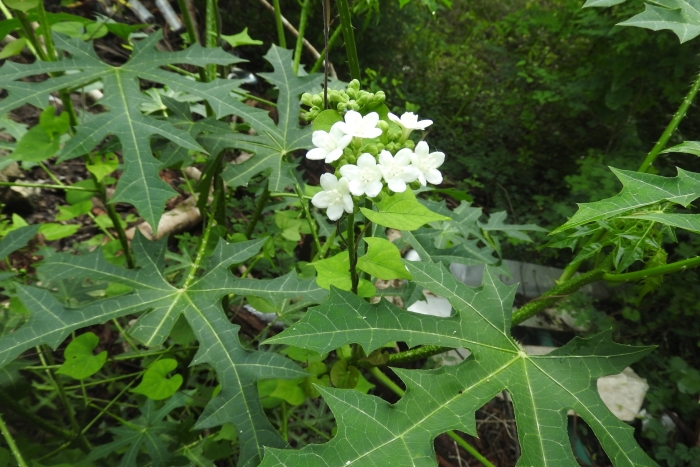Chaya
(Cnidoscolus aconitifolius)
Chaya (Cnidoscolus aconitifolius)
/
/

Sebastián de Jesús Herrera Buenfil
CC BY 4.0
Image By:
Sebastián de Jesús Herrera Buenfil
Recorded By:
Copyright:
CC BY 4.0
Copyright Notice:
Photo by: Sebastián de Jesús Herrera Buenfil | License Type: CC BY 4.0 | License URL: http://creativecommons.org/licenses/by/4.0/ | Rights Holder: Sebastián de Jesús Herrera Buenfil | Publisher: iNaturalist | Date Created: 2021-06-17T10:05:40-07:00 |















Estimated Native Range
Summary
Cnidoscolus aconitifolius, commonly known as chaya or tree spinach, is a fast-growing perennial shrub native to the limestone-rich regions of the Yucatán Peninsula in Mexico and Central America. It can grow up to 20 feet tall but is often pruned to about 6.6 feet in cultivation for easier leaf harvest. Chaya is a semi-deciduous plant with a bushy growth habit and milky sap. Its leaves are a deep green and have a slightly lobed shape, resembling those of oak trees. While not widely known for its flowers, chaya does produce small, inconspicuous white blossoms.
Chaya is valued for its highly nutritious leaves, which are rich in protein, vitamins, and minerals. Due to the presence of toxic hydrocyanic acid, the leaves must be cooked before consumption to ensure safety. In cultivation, chaya is often grown in home gardens for its edible leaves and as a living fence. It thrives in full sun to part shade, requires well-drained soil, and is drought-tolerant once established. Chaya is not commonly affected by pests or diseases, but it is sensitive to frost. It is propagated primarily through stem cuttings, as seeds are rarely produced. Gardeners should be cautious when handling chaya due to its stinging hairs, which can cause irritation.CC BY-SA 4.0
Chaya is valued for its highly nutritious leaves, which are rich in protein, vitamins, and minerals. Due to the presence of toxic hydrocyanic acid, the leaves must be cooked before consumption to ensure safety. In cultivation, chaya is often grown in home gardens for its edible leaves and as a living fence. It thrives in full sun to part shade, requires well-drained soil, and is drought-tolerant once established. Chaya is not commonly affected by pests or diseases, but it is sensitive to frost. It is propagated primarily through stem cuttings, as seeds are rarely produced. Gardeners should be cautious when handling chaya due to its stinging hairs, which can cause irritation.CC BY-SA 4.0
Plant Description
- Plant Type: Shrub, Tree
- Height: 10-20 feet
- Width: 10-20 feet
- Growth Rate: Rapid
- Flower Color: White
- Flowering Season: Summer, Fall
- Leaf Retention: Evergreen
Growth Requirements
- Sun: Full Sun
- Water: Medium, High
- Drainage: Medium, Fast
Common Uses
Drought Tolerant, Edible*Disclaimer: Easyscape's listed plant edibility is for informational use. Always verify the safety and proper identification of any plant before consumption., Low Maintenance
Natural Habitat
native to the limestone-rich regions of the Yucatán Peninsula in Mexico and Central America
Other Names
Common Names: Chaya, Spinach Tree, Treadsoftly, Tree-Spinach
Scientific Names: , Cnidoscolus aconitifolius, Cnidoscolus napaeifolius, Jatropha aconitifolia, Jatropha aconitifolia var. genuina, Jatropha longipedunculata, Jatropha napaeifolia, Jatropha palmata, Jatropha urens var. longipedunculata,
GBIF Accepted Name: